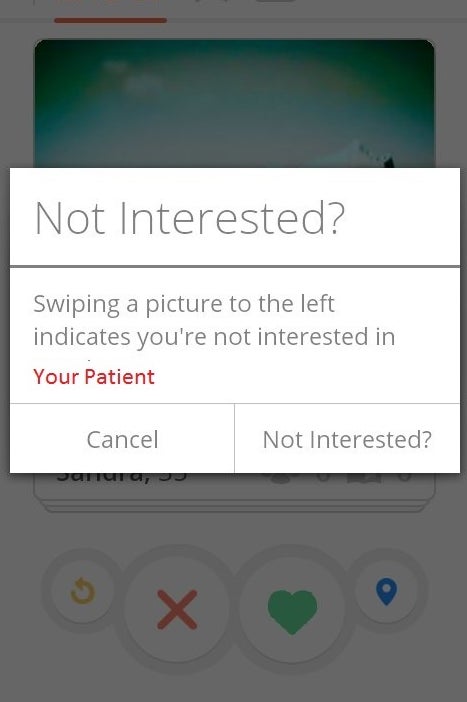
“I am so excited ― I finally started online dating again,” my young male patient excitedly voiced to me in our 50-minute therapy session.
“Oh, that is great, what app are you using?” I heard myself instinctively ask, not because it was important to the conversation or the therapy, but because it was important to determining my own reaction and next move. I was trying to appear casually uninterested, while I was freaking out a little inside.
“OKCupid,” he replied shyly, luckily not asking me why I had asked.
I nodded in reply and, as soon as he left my office, I deleted my own account.
In this age of increasing use of social media, doctors have discussed the murky boundaries of interacting with a patient on these platforms. With the advent of Facebook, Twitter, and LinkedIn, stories from colleagues about “friend requests” from patients have become almost commonplace. Providers in NEJM and USA Today have opined warning of the boundary fluidity and potential for HIPAA violations from accepting such requests. As Dr. Chretien suggests, “We need professional boundaries to do our job well.”
To a psychiatric provider, social media interactions are uniquely complex. While therapists have “life items” that are available to be found online and “stalked” by patients, self-disclosure is purposefully limited in therapeutic relationships. Therapists have long been trained to practice as an almost “blank slate.” There is a range of what people will disclose depending on the type of therapy and the therapist’s own boundaries and comfort level. Psychodynamic theory emphasizes transference (“the redirection of feelings and desires and especially of those unconsciously retained from childhood toward a new object”―usually the therapist); thus, disclosed personal information might interfere with these unconscious feelings and hinder therapy. On the other hand, the founder of dialectical behavioral therapy (DBT) self-disclosed her own borderline personality disorder.
As trainees, we often learn to respond to questions about ourselves with something like, “I wonder why you are asking?” or “I will answer you, but only after we discuss why you are asking.” In practice, sometimes this can feel forced and even awkward, particularly as it goes against social norms. Perhaps that is why one study suggested 90 percent of therapists do some form of self-disclosure, however many keep the fact that they disclose to patients to themselves. It may be hard to go against tradition, but the research findings suggest the tradition itself may be changing.
Yet, even if I may be comfortable telling some patients where I went for a holiday break or that I have the flu, as a psychiatrist, the question of when and what to disclose is always on my mind. One article suggests a rule of thumb for self disclosure as follows:
1) If a psychiatrist believes that a self disclosure most likely will further the patient’s good, it probably will; and, 2) A psychiatrist should self disclose only information about which he or she feels comfortable. If the psychiatrist feels at all nervous about self disclosing, he or she should not self disclose.
This is the crux of the issue of social media. Often what would be disclosed is neither for the patient’s good, nor is it information that the therapist would want to or would feel comfortable disclosing. Outside of the office and on the computer, personal information takes an uncontrolled life of its own.
This is particularly true for dating applications. On sites like Facebook, the privacy settings let you “block” a lot of what “everyone” can see. And, the information that can be gleaned by someone you “reject” is minimal. Yet, dating status and the profile questions on dating apps do not usually fall under the common disclosure items. I personally do not feel comfortable with my patients knowing my relationship status, let alone the pictures I choose or the few lines I write about myself.
But I can’t stop them from seeing me if they are in my “radius.” I can “swipe left,” but what if they already saw me? Unlike real world encounters, I can’t just walk by them and hide, or cordially wave as I pass.
Even still, if I do see patients on a dating app, or they see me, do we discuss it? Truthfully, I can think of few more awkward conversations to have.
For the single therapist, then, what are the options?
One choice is to stop using dating apps entirely. This follows after the advice “if he is on one app, he could be on them all,” or, “if it’s not him, it’s going to be another patient.” Yet, in doing so, we may then doom the young single therapist, or really all doctors, to eternal single-dom simply because of their job choice. Are there truthfully even other patient-boundary safe ways to meet people?
The other option, which I myself prefer, is that doctors remain on social media and dating apps, but with more oversight and awareness of what information is available to the public and who that public might include. Perhaps this means deleting the profile picture of me making a not-so-professional looking face. Or, maybe this means I display a bit less of my hobbies and personality in my bio. It will be OK if someone has to message me to find out I am “not as serious as my job selection might imply.”
Who knows, maybe even next time instead of deleting my profile, I will discuss it preemptively with my patient instead.
I said maybe.